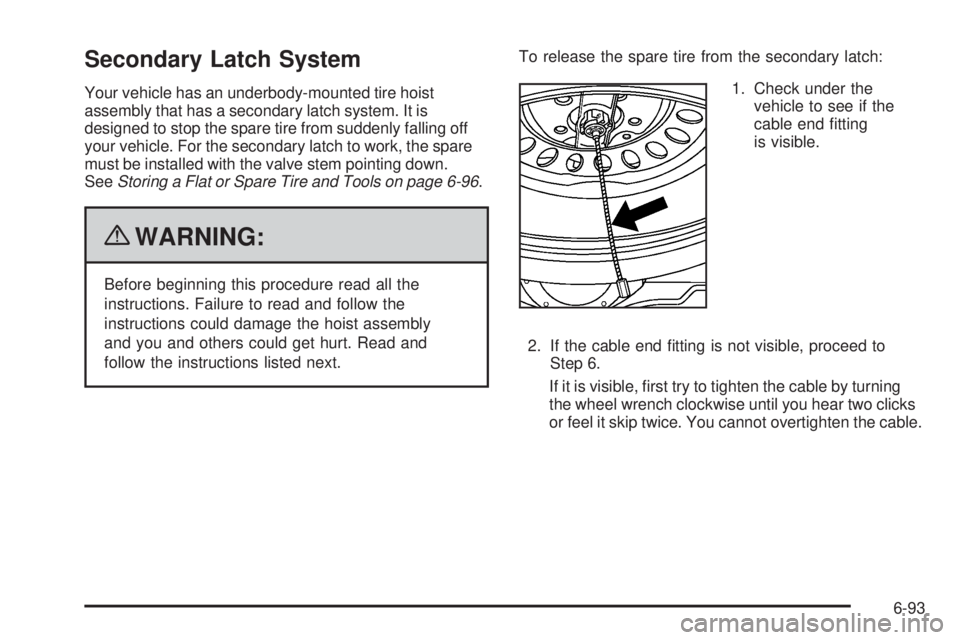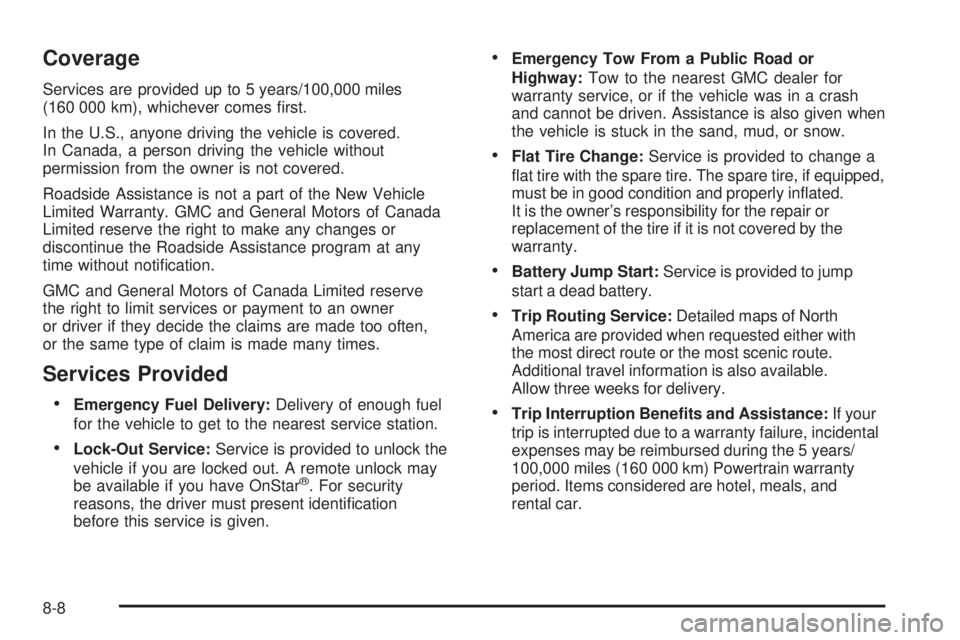2010 GMC CANYON flat tire
[x] Cancel search: flat tirePage 369 of 448

Secondary Latch System
Your vehicle has an underbody-mounted tire hoist
assembly that has a secondary latch system. It is
designed to stop the spare tire from suddenly falling off
your vehicle. For the secondary latch to work, the spare
must be installed with the valve stem pointing down.
SeeStoring a Flat or Spare Tire and Tools on page 6-96.
{WARNING:
Before beginning this procedure read all the
instructions. Failure to read and follow the
instructions could damage the hoist assembly
and you and others could get hurt. Read and
follow the instructions listed next.To release the spare tire from the secondary latch:
1. Check under the
vehicle to see if the
cable end fitting
is visible.
2. If the cable end fitting is not visible, proceed to
Step 6.
If it is visible, first try to tighten the cable by turning
the wheel wrench clockwise until you hear two clicks
or feel it skip twice. You cannot overtighten the cable.
6-93
Page 372 of 448

14. Tilt the tire retainer at the end of the cable and pull
it through the wheel opening. Pull the tire out from
under the vehicle.
15. If the cable is hanging under the vehicle, turn the
wheel wrench clockwise to raise the cable.
Have the hoist assembly inspected as soon as you
can. You will not be able to store a spare or flat
tire using the hoist assembly until it has been
replaced.
To continue changing the flat tire, seeRemoving the
Flat Tire and Installing the Spare Tire on page 6-85.
Storing a Flat or Spare Tire and
Tools
{WARNING:
Storing a jack, a tire, or other equipment in the
passenger compartment of the vehicle could
cause injury. In a sudden stop or collision, loose
equipment could strike someone. Store all these in
the proper place.
Notice:Storing an aluminum wheel with a �at tire
under your vehicle for an extended period of time
or with the valve stem pointing up can damage
the wheel. Always stow the wheel with the valve
stem pointing down and have the wheel/tire repaired
as soon as possible.
6-96
Page 377 of 448

Spare Tire
Compact Spare Tire
Your vehicle may have a compact spare tire. Although
the compact spare tire was fully inflated when your
vehicle was new, it can lose air over time. Check the
inflation pressure regularly. It should be 60 psi (420 kPa).
Notice:If the vehicle has four-wheel drive and the
compact spare tire is installed on the vehicle, do not
drive in four-wheel drive until you can have the �at
tire repaired and/or replaced. You could damage the
vehicle, and the repair costs would not be covered by
your warranty. Never use four-wheel drive when the
compact spare tire is installed on the vehicle.
After installing the compact spare on your vehicle, you
should stop as soon as possible and make sure your
vehicle’s spare tire is correctly inflated. The compact
spare is made to perform well at speeds up to 62 mph
(100 km/h) for distances up to 500 miles (804 km).
For heavy payloads or towing, and for low traction or
four-wheel-drive conditions, repair or replace the full-size
tire. Of course, it is best to replace your vehicle’s spare
with a full-size tire as soon as you can. The spare tire
will last longer and be in good shape in case you need
it again.Notice:When the compact spare is installed,
do not take the vehicle through an automatic car
wash with guide rails. The compact spare can
get caught on the rails which can damage the
tire, wheel and other parts of the vehicle.
Do not use your compact spare on other vehicles.
And do not mix your compact spare tire or wheel with
other wheels or tires. They will not fit. Keep your
spare tire and its wheel together.
Notice:Tire chains will not �t the compact spare.
Using them can damage the vehicle and can damage
the chains too. Do not use tire chains on the
compact spare.
Full-Size Spare Tire
Your vehicle may have a full-size spare tire, which,
when new, was fully inflated. A spare tire may lose
air over time, so check its inflation pressure regularly.
SeeIn�ation - Tire Pressure on page 6-64andLoading
the Vehicle on page 5-33for information regarding proper
tire inflation and loading your vehicle. For instruction
on how to remove, install, or store a spare tire, see
Removing the Flat Tire and Installing the Spare Tire
on page 6-85andStoring a Flat or Spare Tire and
Tools on page 6-96.
6-101
Page 420 of 448

Coverage
Services are provided up to 5 years/100,000 miles
(160 000 km), whichever comes first.
In the U.S., anyone driving the vehicle is covered.
In Canada, a person driving the vehicle without
permission from the owner is not covered.
Roadside Assistance is not a part of the New Vehicle
Limited Warranty. GMC and General Motors of Canada
Limited reserve the right to make any changes or
discontinue the Roadside Assistance program at any
time without notification.
GMC and General Motors of Canada Limited reserve
the right to limit services or payment to an owner
or driver if they decide the claims are made too often,
or the same type of claim is made many times.
Services Provided
•Emergency Fuel Delivery:Delivery of enough fuel
for the vehicle to get to the nearest service station.
•Lock-Out Service:Service is provided to unlock the
vehicle if you are locked out. A remote unlock may
be available if you have OnStar
®. For security
reasons, the driver must present identification
before this service is given.
•Emergency Tow From a Public Road or
Highway:Tow to the nearest GMC dealer for
warranty service, or if the vehicle was in a crash
and cannot be driven. Assistance is also given when
the vehicle is stuck in the sand, mud, or snow.
•Flat Tire Change:Service is provided to change a
flat tire with the spare tire. The spare tire, if equipped,
must be in good condition and properly inflated.
It is the owner’s responsibility for the repair or
replacement of the tire if it is not covered by the
warranty.
•Battery Jump Start:Service is provided to jump
start a dead battery.
•Trip Routing Service:Detailed maps of North
America are provided when requested either with
the most direct route or the most scenic route.
Additional travel information is also available.
Allow three weeks for delivery.
•Trip Interruption Bene�ts and Assistance:If your
trip is interrupted due to a warranty failure, incidental
expenses may be reimbursed during the 5 years/
100,000 miles (160 000 km) Powertrain warranty
period. Items considered are hotel, meals, and
rental car.
8-8
Page 436 of 448

Engine
Air Cleaner/Filter.........................................6-20
Check and Service Engine Soon Lamp...........4-28
Compartment Overview................................6-12
Coolant......................................................6-29
Coolant Heater............................................3-20
Coolant Temperature Gage...........................4-27
Cooling System...........................................6-27
Drive Belt Routing.......................................7-13
Exhaust.....................................................3-34
Fan Noise..................................................6-36
Oil .............................................................6-15
Overheating................................................6-35
Starting......................................................3-18
Engine Identification......................................6-110
Engine Oil
Life System................................................6-18
Engine Oil Additives / Engine Oil Flushes...........6-18
Engine Oil Life System....................................4-34
Environmental Concerns..................................5-15
Event Data Recorders.....................................8-17
Exit Lighting...................................................4-14
Express-Down Windows...................................3-12
Extender, Safety Belt.......................................2-34
Exterior Cargo Lamps......................................4-13
Exterior Lamps...............................................4-10
Exterior Mirrors...............................................1-11F
Federal Communications Commission (FCC) and
Industry and Science Canada........................6-67
Filter
Engine Air Cleaner......................................6-20
Finding a Program Type (PTY) Station
(RDS and XM) ............................................4-49
Finding a Station............................................4-46
Finish Damage.............................................6-109
Fixed Mast Antenna........................................4-63
Flashers, Hazard Warning.................................. 4-3
Flash-to-Pass................................................... 4-5
Flat Tire........................................................6-79
Flat Tire, Changing.........................................6-80
Flat Tire, Storing.............................................6-96
FLUID ...........................................................4-38
Fluid
Automatic Transmission................................6-21
Power Steering...........................................6-37
Windshield Washer......................................6-38
FM Stereo.....................................................4-62
Fog Lamps
Bulb Replacement.......................................4-12
Following Distance..........................................5-57
Four-Wheel Drive....................................3-25, 6-48
Front Axle......................................................6-49
6
Page 443 of 448

Rear Safety Belt Comfort Guides......................2-30
Rear Seat Operation...............................2-10, 2-11
Rear Storage.................................................3-41
Rearview Mirrors.............................................3-36
Automatic Dimming......................................3-36
Reclining Seatbacks...................................1-8, 2-5
Recommended Fluids and Lubricants.................7-10
Recovery Hooks.............................................5-32
Recreational Vehicle Towing.............................5-41
REDUCED POWER........................................4-40
Reimbursement Program, GM Mobility................. 8-7
Remote Keyless Entry (RKE) System.................. 3-3
Removing the Flat Tire and Installing the
Spare Tire..................................................6-85
Removing the Spare Tire and Tools...................6-81
Repair Facility................................................8-12
Replacement Bulbs.........................................6-54
Replacement Parts
Maintenance...............................................7-12
Replacing Brake System Parts..........................6-42
Reporting Safety Defects
Canadian Government..................................8-15
General Motors...........................................8-15
U.S. Government.........................................8-14
Restraint System Check
Checking the Restraint Systems....................2-81
Replacing Restraint System Parts
After a Crash..........................................2-82
Retained Accessory Power (RAP)......................3-18Ride Control Systems
Limited Slip Rear Axle................................... 5-9
Roadside Assistance Program............................ 8-7
Rocking Your Vehicle to Get it Out....................5-32
Roof
Sunroof......................................................3-42
Running the Vehicle While Parked.....................3-34
S
Safety Belt Pretensioners.................................2-29
Safety Belt Reminder Light...............................4-21
Safety Belts...................................................2-81
Care of ....................................................6-105
Extender....................................................2-34
How to Wear Safety Belts Properly................2-18
Lap Belt.....................................................2-33
Lap-Shoulder Belt........................................2-27
Reminders..................................................4-21
Safety Belts Are for Everyone.......................2-13
Use During Pregnancy.................................2-33
Safety Chains.................................................5-55
Safety Defects Reporting
Canadian Government..................................8-15
General Motors...........................................8-15
U.S. Government.........................................8-14
Safety Warnings and Symbols.............................. iv
Scanning the Terrain.......................................5-16
13
Page 446 of 448

Tires (cont.)
Changing a Flat Tire....................................6-80
Cleaning...................................................6-108
Different Size..............................................6-75
High-Speed Operation..................................6-65
If a Tire Goes Flat.......................................6-79
Inflation - Tire Pressure................................6-64
Inspection and Rotation................................6-71
Installing the Spare Tire................................6-85
Pressure Light.............................................4-28
Pressure Monitor Operation...........................6-67
Pressure Monitor System..............................6-66
Removing the Flat Tire.................................6-85
Removing the Spare Tire and Tools...............6-81
Secondary Latch System..............................6-93
Sidewall Labeling.........................................6-58
Spare Tire................................................6-101
Storing a Flat or Spare Tire and Tools............6-96
Terminology and Definitions...........................6-61
Uniform Tire Quality Grading.........................6-75
Wheel Alignment and Tire Balance.................6-77
Wheel Replacement.....................................6-77
When It Is Time for New Tires......................6-72
To Use the Engine Coolant Heater....................3-20
Torque Lock (Automatic Transmission)...............3-32
Total Weight on the Vehicle’s Tires....................5-54Towing
Recreational Vehicle.....................................5-41
Towing a Trailer..........................................5-48
Trailer Recommendations..............................5-60
Your Vehicle...............................................5-41
TPMS Malfunction Light and Message...............6-68
TPMS Sensor Matching Process.......................6-69
TRAC (Traction) OFF......................................4-41
Traction
Control System (TCS).................................... 5-8
Limited-Slip Rear Axle.................................... 5-9
StabiliTrak®System....................................... 5-6
TRACTION FAULT ..........................................4-41
Traction – AA, A, B, C.....................................6-76
Trailer
Towing Recommendations.............................5-60
Trailer Brakes.................................................5-55
Trailer Wiring Harness.....................................5-60
Transfer Case................................................6-48
Transmission
Fluid, Automatic...........................................6-21
Fluid, Manual..............................................6-25
Transmission Operation, Automatic....................3-21
Transmission Operation, Manual........................3-23
Transportation Options.....................................8-10
Transportation Program, Courtesy......................8-10
16